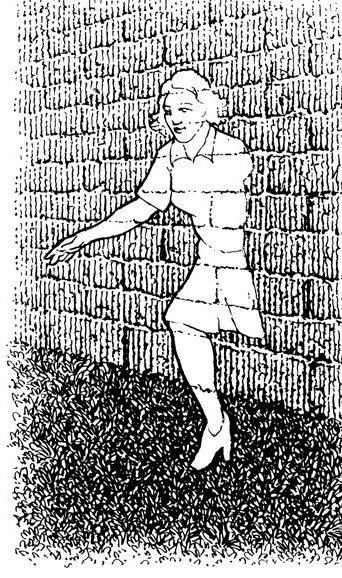A Field Guide to Lucid Dreaming (21 page)
Read A Field Guide to Lucid Dreaming Online
Authors: Dylan Tuccillo,Jared Zeizel,Thomas Peisel

like. Watch as the colors and shapes begin to blend together. As
you slow down, the new location will have formed. Paired with a
strong intention, this is one of the best ways to change the dream
location.
=
136
<





Walking Through
Walls
Now that you’re in the landscape of
your own mind, it’s time to explore
a little. Test the environment and touch
things, feel their life-like weight and tex-
ture. When it comes to lucid dreaming,
one of the simplest but most interest-
ing experiences is walking through solid
objects. In the dream world, obstacles
only appear to be in your way. A window,
a brick wall, a rock face—these things
are only illusions, projections from your
mind. They are not physical. Objects may feel solid when you
touch them, but they feel solid only because you expect them to
In this lucid dream, I just practiced going through things: glass,
wood, and tile. I was curious what each one would feel like.
I conjured up a pen and paper in my dream and wrote down my
observations. Glass felt like ice. I went through it and stayed in
it, my arm penetrating this glass door in front of me. It felt really
cold. Wood felt like sand, it was grainy. Then I went through tile,
and it felt like chalk. I was amazed at the feeling these “objects”
generated when I went through them. I wrote these down in
my dream, but unfortunately I couldn’t bring back these records.
—ThoMAS P.
=
137
<
feel that way. Think of the object as air, and you will pass through
it effortlessly.
Time Travel
In the playground of your subconscious, you can step across the
sands of time like you’re walking to work. Without the con-
straints of the space-time continuum a dreamer can travel to any
historical era or futuristic landscape he or she desires. People,
places, and times can all be accessed. In the same way you can
bend space, you can bend time. The dream world is boundless and
infinite, and everything is available to you in that one big now.
1. Incubation.
During your wake-back-to-bed, decide on a particu-
lar time and place. Let’s say you’re a big World War II fan and want
to arrive in 1945. Spend the last twenty minutes before you go to
bed looking at a picture of the era, such as the Times Square shot
of the V-J Day kiss. Find video or music from that period as well.
This is all to help support your intentions.
2. Build yourself a time machine.
If you become lucid and you’re
not in the time period of your choice, you’ll have to travel there.
Because our minds are hardwired with “cause and effect,” it’s handy
to use a time machine or portal to get you to your desired time
period. Your time machine can be anything from a simple wooden
doorframe to a DeLorean DMC-12. It should be something you
can relate to, something you believe will do the job. Robert Moss,
in his book
Dreamgates,
suggests something more organic than a
=
138
<
machine. Visualize a river, he says, “The River of Time.” Wading
into its waters will bring you into a scene from another era.
3. restate intention.
Before walking through the door, stepping
into the river, or starting up your contraption, say your intention
out loud. “When I open this door, it will be 1945.”
�
Summary
• Moving around the dream world will enrich your dream
adventure: transportation is practical in getting to places and it
also provides an experience in and of itself.
• To help move in the dream, create a way to convince your
mind that it’s possible to do the impossible: swim through the air,
conjure up a magical door, create a time machine, etc.
• While flying or getting around in the dream, all you really need
is a focused thought or intention. Nothing else is really necessary.
• Time, space, and physical objects are just illusions in your dream.
even though your surroundings look real, “reality” can easily be
bent.
=
139
<
=
140
<
12
Creation
<•=
Life isn’t about finding yourself. Life is about creating yourself.
—George Bernard Shaw,
Irish literary critic, playwright, and snarky gentleman
In 1888, there were still a lot of blank spots on the map of the
American frontier. It was December eighteenth of that year
when two cowboys were riding through the Indian territory
of southwest Colorado, looking for stray cattle. They stopped their
search for cows when they found something else: an ancient clay
city built into a huge cliff, abandoned nearly one thousand years
earlier by its inhabitants. In the following months, with the help
of a Swedish archaeologist, the cowboys explored and excavated
the city. They cataloged this amazing feat of creation, the largest
cliff dwelling in North America, now called Mesa Verde. It was still
filled with objects and art from an early pueblo society.
=
141
<
Creation is at the core of the human spirit. Throughout time,
every individual and society has had the overwhelming urge to
create. Whether you’re an artist, baker, mason, or just an average
joe, everyone is a creator in his own right. Even if you’re not finger
painting as much as you did when you were six years old, you’ve
still crafted your own life, haven’t you?
We’re different from other animals in our capacity to create
and forge new ideas through our will and imagination. This power
has allowed us to shape the world around us, as well as influence
our own individual experience. The thoughts and beliefs we have,
and the actions that we take, mold the world around us. You’ll find
that it works the same in the dream world.
Creation Principles
In a lucid dream, you can create anything. Nothing is off-
limits—no object, creature, or contraption is out of reach.
Your creation can be as large as a mountain or as complicated as
a living organism. If you could create the impossible, what would
you make? While any act of creation is within reach, this chapter
will focus on four techniques: the basics of creation, conjuring up
friends or family, dream art, and thinking big.
But before we discuss the step-by-step techniques, there’s an
important question to consider—how do we create in our dreams?
When you find yourself fully self-aware, there are a couple of prin-
ciples to take note of. First off, the dream world might look like
the physical world, but there are key differences. Rules, laws, and
customs work a bit differently here.
=
142
<

1. Thoughts and emotions create your reality.
Your thoughts have
a very powerful effect on the dream world. Whatever you think
about in the dream directly influences the environment around
you. If you’re calm you may find yourself near a placid lake.
Anxiety or fear in the dream can result in nightmares. Therefore
intention and focused thought is key. By focusing your thoughts
on a specific place, object, person, or outcome, you will instanta-
neously create those circumstances around you. Our subconscious
thoughts create every building, prop, and event within the dream.
I THINK THEREFORE I’M SCATTERED
humans have up to forty to fifty thousand thoughts a day, so if thoughts
create our dreams, it’s no wonder that our dreams can sometimes be a bit
disorganized and erratic, especially if we are unconscious within them. A good
intention organizes that clutter like a determined chambermaid.
